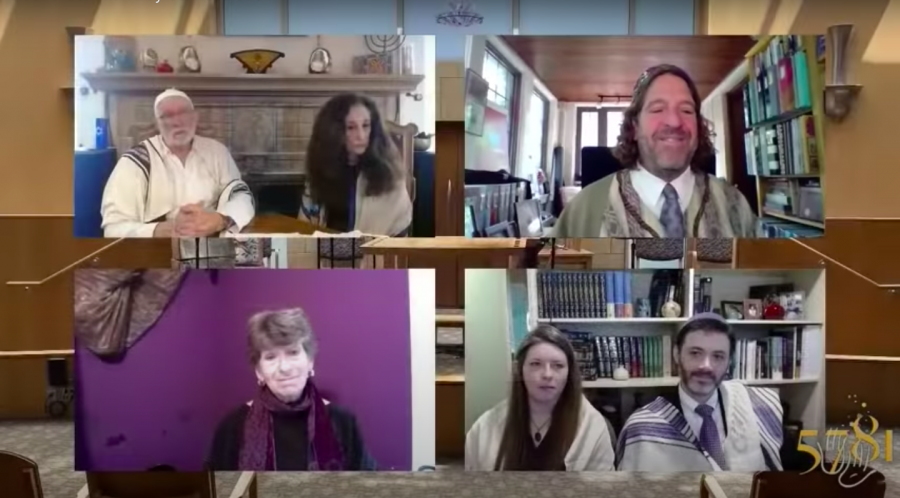St. Louis congregations adapt to COVID-19 for High Holy Days
Published November 20, 2020
Family, community and celebration go hand-in-hand with the High Holy Days. But in the midst of a pandemic, a lot of the typical traditions of the holidays had to be re-imagined. As a result, many congregations in the Reform and Conservative movement decided to live stream their services in order to keep their congregants safe, while some Orthodox synagogues decided to conduct their services outside.
“I thought that the services were very similar compared to other years. If we had been virtual, I think the service would have a different feel to it,” said Sarah Pernik, a junior at Ladue Horton Watkins High School. Pernik attended Nusach Hari B’nai Zion (NHBZ) for the Rosh Hashanah and Yom Kippur services.
NHBZ conducted its services in person, but outdoors. Everyone was required to wear a mask, and the chairs were under tents and spread out.
ADVERTISEMENT
“I think they did [the service] pretty well,” Pernik added. “They did the most they could.”
The decision to have a traditional, in-person service was significantly influenced by the fact that a lot of Orthodox congregants couldn’t watch a service online during the holiday due to halachic law, which bars turning on technology. Reform congregations didn’t have to overcome that barrier since the large majority of their congregants were happy with watching online.
“There was one day back in March when we did Shabbat services socially distanced in the building, and that only lasted one day,” said Rabbi Daniel Bogard of Central Reform Congregation. “ So what we ended up doing (for the High Holidays) was that all (CRC) rabbis led the services from their own homes.”
Bogard and Jake Talve-Goodman, the manager of CRC’s building and operations, played a large role in managing the technology of the congregation’s virtual services. Bogard had multiple programs running on a computer he got to produce the services, and he also did hours of the behind-the-scenes work for each service.
ADVERTISEMENT
Early in April, the CRC board and rabbis realized that there was no way to make a quality online production without putting a lot of time and effort into the assembly of the service. They had to find a sustainable way to keep their congregants engaged.
“We looked into hiring a company to produce the service, and we got a discounted bid, but we really just figured out how to do it in-house,” said Bogard.
By hiring the company and producing services in tandem with them, CRC was able to save a lot of money. To compound the savings, there wasn’t any of the normal expenditures, such as paying for security, that the congregation usually has during the High Holy Days.
Bob Sterneck, who is going on his sixth year as the treasurer of United Hebrew, and Rabbi Carnie Rose of Congregation B’nai Amoona, think that virtual services are necessary, but each is unsure how they will affect congregants going forward.
“Synagogue is a beit tefillah, a beit midrash and a beit knesset; a house of study, house of prayer and a house of gathering. We may be praying and we may be studying, but one of the three main functions of a synagogue isn’t happening right now,” said Rose.
He and the other leaders of B’nai Amoona had to find a way to make sure that all congregants would have access to services since some of them abide by the halachic law. Luckily, the Rabbinic Assembly, which is the rabbinic body of the Conservative movement, made a deal with Zoom that allowed computers and Zoom rooms to stay online for extended periods of time. Rose calls this a “Kosher Zoom.”
“Now there are people who can join us on Zoom and they can leave their machine on all Shabbat,” said Rose. “You don’t fidget with it at all during the course of the service, and it’s simply on.”
B’nai Amoona also hosted services in its sanctuary but with only 50 people. Congregants had to sign up prior to attending.
One underlying theme of virtual services is the challenge of creating a similar atmosphere of community that congregants feel from in-person services. Bogard has thought about utilizing Zoom for services in a similar way to how Rabbi Rose and B’nai Amoona have been using it.
Sterneck has thought about the ways that United Hebrew can keep people engaged too, and he thinks that there are a lot of good things that came out of the holiday services.
“There were a lot of new experiences that some people really enjoyed,” he said.
Each synagogue has taken a different approach at creating a community through virtual services. CRC rabbis are filming their services from their homes. In contrast, B’nai Amoona and UH have been going into their building to film or stream their services.
With the success of virtual services, some local congregants may be questioning whether they need to be members of a synagogue when they can watch services on free platforms from the comfort of their home.
“A lot of people could realize that if they only go to temple two or three times a year, why should they pay dues when they can see [the service] for free?” said Sterneck.
Fortunately for the congregations, there is one factor that online services cannot provide: a beit knesset, a house of gathering. For a number of people, the primary reason to attend services isn’t so much for religious purposes as it is to connect with other congregants and the rabbis.
“I think that an in-person service has a better sense of community, which is something that you can’t get from a screen,” said Pernik.
“I’m profoundly optimistic that we will get back together as a community and that people want us to get back together as a community. Now it’s a matter of how to congregate in a safe manner,” added Rose.
















